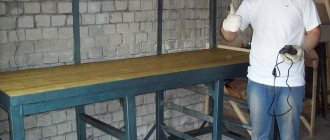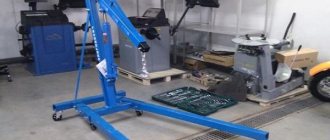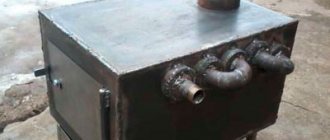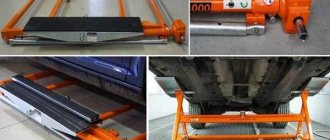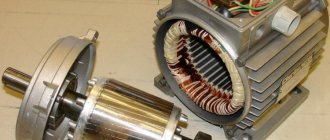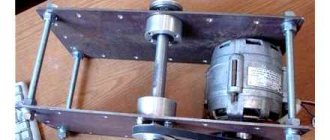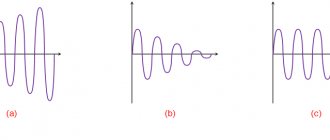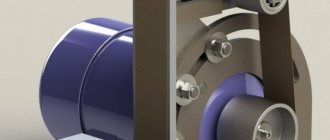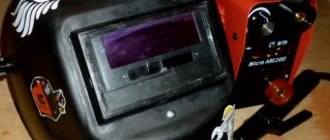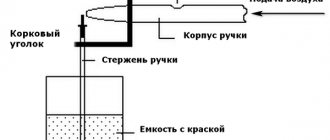During operation, some engine components wear out. This situation is typical for cars of any year of manufacture. However, if a part is damaged, you should not rush to buy a new one. Welding the exhaust manifold helps postpone the replacement procedure to a more favorable time.
The exhaust manifold is part of the attachments of an internal combustion engine.
Welding the exhaust manifold
One of the components of the internal combustion engine is the exhaust manifold. It wears out during use. This is typical for a car with any mileage. There are many reasons for the formation of cracks: from manufacturing defects, incorrect assembly to dynamic destruction. If a part fails, do not rush to replace the spare part. Many car repair shops specialize in welding exhaust manifolds. Having a welding machine in the garage, you can restore the part yourself. This can be done in several ways. The collector is made of stainless pipes or cast iron. Both alloys can be welded, but each technology has its own nuances. Experts are ready to share their experience.
general information
Regardless of the vehicle, it can be equipped with a tubular or solid manifold. The one-piece unit is cast from cast iron and has no seams. It is the most durable and durable. Tubular is made by welding several pipes into a single system. This option is less reliable, but more repairable, since it is often the seams that burst and can be re-fused without any problems.
The collectors themselves are made of cast iron, heat-resistant steel or aluminum. The unit is cooled using air, but sometimes this is not enough. In critical situations, the collector becomes severely overheated or overcooled, seams burst, cracks or other visible defects form.
Cracks can be caused by engine malfunctions, improper operation of the catalyst, careless driving through puddles and slush, improper engine washing, aggressive driving, and much more. Sometimes frequent breakdowns are associated with manufacturing defects or the manufacturer’s desire to shorten the life of the car. Modern automakers do not prioritize the quality of their cars, often making components from low-quality metal or making mistakes during assembly. Welding of the collector is necessary if the cracks have reached a length of 5 centimeters or more, if fragments of the collector have burned out, the collector itself has split into several components, or the seams have burst.
Exhaust manifold: causes of failure and maintenance
Depending on the make of the car and the type of engine, models of various modifications are installed on the engine. They can be divided into two groups:
The manifolds are attached to the internal combustion engine block using flanges. At each stroke, exhaust gases enter the chamber under pressure. Their temperature reaches 900 degrees. It is clear that a part operating in this mode can break.
A leak in the exhaust manifold is the most difficult defect. Possible situations:
All this damage is a problem. For many cars, the procedure for replacing a part drags on for months - “original” spare parts sometimes have to be ordered.
Many service stations restore them. Welding of collectors, depending on their modification, is carried out using hot, cold or argon welding methods. The work is carried out using different types of equipment, using electrodes or filler wire. Restoration can be done in the courtyard or garage. How to weld the exhaust manifold yourself? Let's consider each of the methods in detail.
Main causes of breakdowns
In the exhaust system, especially of an old car with a lot of mileage, problems arise that are independent of the muffler material, so every driver should periodically inspect the entire system for cracks or burnouts. Timely maintenance will save the car owner from problems with replacing the exhaust manifold , which is very expensive.
The safety of the exhaust gas exhaust system is affected by:
- exhaust gases having a high temperature;
- aggressive mixtures;
- vulnerability of the metal under high loads during operation.
The problems that arise are divided according to the design elements of the exhaust system:
- The particulate filter (catalyst) serves to retain the soot contained in the exhaust gases, so the honeycomb segments become heavily clogged, and due to high temperatures the segments melt. Signs of problems - gases practically do not come out of the exhaust pipe or acrid bluish smoke appears.
- Oxygen sensors - the housing is depressurized or overheated, wear and tear occurs, there is no contact in the electrical circuit of the machine, mechanical damage has occurred.
- The corrugation in the muffler is a cylinder, inside of which there is a corrugated tube protected by a double braid, the top layer of which is made of stainless steel. The housing is elastic, therefore it dampens negative vibrations and prevents destruction of the entire system - rupture occurs due to a sharp increase in gas pressure when the catalyst is clogged.
- The resonator is installed in front of the main muffler, so many car enthusiasts call it a small or additional similar element of the exhaust system. If the volume of gases escaping or vibrating sounds at the installation site of the resonator has increased, this indicates that one of the internal components of the product has burned out.
- The muffler indicates that it needs to be repaired or urgently replaced by loud sounds when the internal combustion engine is running or a sharp drop in engine power, as well as strong vibration at the mounting location.
- Exhaust manifold , if you smell exhaust gases in the cabin, it means that a crack has appeared on its body or the pipe has ruptured.
The damage described above also occurs from exposure to aggressive substances scattered on city streets to combat ice, for example, in the form of salt.
Welding a cast iron exhaust manifold
Temperature processing of a high-carbon alloy is associated with certain difficulties:
Welding a cast iron exhaust manifold can be done by trainees. It is better for beginners not to undertake the restoration of a car engine part, or they should first practice on junk cast iron products. Until recently, welders did not undertake repairs to cast iron. The seam turned out to have a high content of scale, and the metal cracked in the heating zone. After the advent of special copper-containing electrodes, which made it possible to reduce the temperature in the melt bath to +120°C, it became possible to create strong connections.
Hot and semi-hot methods are not fundamentally different. The crack is welded with copper-containing additives when the part is preheated. When hot, the part is heated in the oven to a temperature of +600°C, a crimson tint appears. It is noticeable when shaded. After this, welding begins. To prevent the part from cooling down quickly, it is periodically heated with a blowtorch. With the semi-hot method, the part is heated within +300°C. The result is an even seam. It is very important to maintain the temperature during cooling. If the crack depth is large, it:
They make a multilayer connection. Each seam must be forged, the penetration length is no more than 3 cm. The seams are made perpendicular to ensure a reliable connection. For electric arc welding, electrodes of the TsCh-4 brand are used.
The cold method does not require preliminary preparation. The crack is fused at temperatures up to 200°C. For work, special electrodes OZCH-6, OZCH-2 are used.
The fracture strength of a cold joint is lower. For critical connections (when the outlet manifold pipe is completely broken off), it is better to take MNCh-2 electrodes. When semi-automatic gas welding, copper filler wire is used.
Gas welding
The advantages of the gas welding method include:
- simplicity of the equipment used;
- low cost;
- lack of a constant current source;
- possibility of adjusting the power of the burner flame;
- slow heating and cooling;
- the strength of the resulting seam.
The technology of gas welding of cast iron with heating includes:
- Preheating.
- Heating the metal at the welding site until it turns light red.
- Applying flux to the welding surface using a filler rod.
- Melting the filler rod and filling the seam. At the tip of the filler rod, flux must be added periodically as it is used up.
- Keep the weld pool in a liquid state until gases and non-metallic inclusions are completely removed from it.
- Retracting the burner smoothly, reduce the cooling speed.
The technology of gas welding without heating has its differences:
- It is necessary to set the maximum possible burner flame power.
- Before filling the weld pool, the areas adjacent to the welding site are slightly heated.
- Flux is applied.
- The weld pool is filled with molten filler rod.
- Once again, the adjacent areas are heated for two to three minutes, gradually moving the burner away.
For slower cooling, you can cover the welding area with a sheet of asbestos or sprinkle it with dry sand. Welding the engine block with argon will bring good results.
The advantage of argon welding is the ability to weld refractory metals. This makes it possible to weld parts made of aluminum, which is important when welding an aluminum cylinder block.
The peculiarities of welding aluminum and alloys based on it include its easy oxidation, increased solubility of hydrogen in molten aluminum, a high coefficient of linear thermal expansion, and a decrease in strength under strong heating.
When welding aluminum alloys, there is a danger of porosity appearing in the weld metal. This is explained by the fact that when molten aluminum interacts with water vapor, the formation of atomic hydrogen begins, which easily dissolves in the weld pool. The formation of pores is promoted by a high rate of crystallization, which begins to prevent the escape of gases.
Preheating and reducing the welding speed help reduce the likelihood of porosity. When gas welding, it is permissible to use acetylene and hydrogen, as well as a propane-butane mixture, as flammable gases.
Welding a stainless steel manifold
Tubular components usually burn out at bends. Difficulties of working with stainless steel:
To eliminate defects, the argon welding method is used. The protective atmosphere protects the metal from oxidation; due to the airflow, the area bordering the working area heats up less. It must be taken into account that the thermal conductivity of stainless steel is lower than that of black low-carbon alloys. A small operating current is needed; it is selected experimentally. It is important to observe the speed of seam formation. The metal is welded in large passes so that intercrystalline corrosion does not occur in the joint area. The operating mode depends on the equipment used.
Intake manifold
It turned out not very aesthetically pleasing.
It's good that these places are not in plain sight. It turned out not very aesthetically pleasing. It's good that these places are not in plain sight.
The restoration work took about an hour. For good access to the repair areas, it was necessary to remove the individual ignition coils. The sealant and a bottle of cleaner cost 300 rubles. The repeated test for air leaks after the seal had dried was successful - the speed stopped floating!
Restoring the tightness of the intake system on the editorial Kalina
Cold welding when repairing the exhaust manifold
Small defects are repaired using special adhesives called “cold welding”. Before applying the mixture, the area to be repaired must be degreased. Adhesives should be used strictly according to the instructions. Then the result is a patch whose physical properties are similar to metal. This method is convenient for eliminating cracks and burnouts in hard-to-reach places. Glue is only a temporary measure to fix the damage. Under heavy loads of hot gases leaving the cylinders, the patched components will not last long. The adhesive composition is not designed for dynamic loads, but it can withstand static loads very well. Before purchasing glue, it is important to study its characteristics.
Lada Kalina 2 from ZR park
Lada Kalina 2 from the ZR park
Lada Kalina 2 from the ZR park
Are there any volunteers?
Armed with theory, we will repair the intake system on the editorial Kalina. The composite plastic path of the 1.6 naturally aspirated gasoline engine (106 hp) leaks around the perimeter of the wells for the ignition coils. Apparently, these are the consequences of frequent tests on the Smolensk Ring race track, in which the car and especially its engine were driven to the limit of their capabilities.
How to weld exhaust manifolds
During operation, some engine components wear out. This situation is typical for cars of any year of manufacture. However, if a part is damaged, you should not rush to buy a new one. Welding the exhaust manifold helps postpone the replacement procedure to a more favorable time.
The exhaust manifold is part of the attachments of an internal combustion engine.
Equipment and materials
To weld a cast iron collector, it is better to use an inverter and a cold method , as it is most suitable for home conditions.
The guarantee of success is the following components: welding mode and choice of electrodes, and you need to use special products containing nickel or copper. Domestic manufacturers offer the following brands for this type of work:
- OZCh-2 and OZCh-6 , where the base is a copper rod, which is covered with coating, where iron powder is present;
- iron-nickel electrodes for DC welding;
- Copper-iron-nickel MNC-2 allows you to obtain a high-tech type of seam joint that prevents the formation of corrosion and perfectly withstands contact with aggressive environments and hot gases.
[stextbox Emelyanov, education: college, specialty: 5th category welder, work experience: since 2000: “When choosing the required electrode, the thickness of the part, the total weight and operating conditions are taken into account, the correct selection is the key to a strong connection.”
Causes and signs of parts failure
The most common malfunctions are a violation of the integrity of the pipe or the appearance of a through hole in the manifold. The main sign of a breakdown is the smell of exhaust gases in the car interior. Malfunctions arise due to the negative effects of chemicals contained in mixtures used during icy conditions. Another reason is the natural wear of the part under constant exposure to high temperatures. Burnout of exhaust system components is not considered a rare failure.
A sign of a faulty collector is unstable operation at low speeds.
What is a collector + reasons for its breakdowns
In a car system, a manifold refers to an intake or exhaust part located on both sides of the engine. As a rule, the elements do not have points of contact; moreover, in 90% of cases they are made of various metal alloys.
The collector's tasks are determined by its type:
- inlet. The task of the part is to supply and assist in mixing the fuel mixture before it enters the cylinders of the engine system;
- high school graduation. Performs a removal function where burnt gases act as transport raw materials. The waste first enters the catalyst and is then fed to the muffler.
The structure of both types of manifolds is also very similar - these are from 2 to 6 tubes combined into one, which are “dressed” on the engine cylinders. The number of pipes depends on the number of cylinders, and in 2020 they can be found as old models (the same “OKA”) with 2 cylinders, or advanced American gas-guzzling “monsters” with 6 cylinders. According to the classics, these are 4 cylinders.
A photo of the intake manifold is shown above. It is connected to the fuel + air supply system. At the top of the part there will be either a throttle valve or a carburetor.
Operating principle of the exhaust manifold:
- After fuel enters the engine, the valves close.
- The spark plug mixture is ignited.
- The piston moves downward due to the resulting explosive force.
- The exhaust valves come into operation, diverting burnt fuel residues and gases into the exhaust manifold. Each pipe has a collector inlet, which at the end combines all the branches into a single whole.
- The catalyst ignites the mixture from the pipe.
- Combustible particles are sent either to the pipe outlet or directly to the muffler.
- Gases escape into the external environment.
The output manifold + muffler suppresses sounds from the engine, making the vehicle's ride soundly comfortable for those around it.
Important: the exhaust manifold is constantly exposed to significant temperature shocks - from 600 to 950 degrees Celsius. It is logical to assume that the material used to make the part must have high heat resistance, and only refractory metals can provide this.
The situation is similar with welding. If low-quality material is used to patch the collector, there can be no question of the durability of the work done. In most cases, the exhaust manifold is supplemented with a special sensor that helps monitor the oxygen level in the exhaust. It helps adjust the composition of the fuel mixture supplied to the engine. The result is an invisible relationship between the components of the system.
Now let's talk about the classification of exhaust system problems.
The specified problems arise due to the influence of chemicals contained in mixtures distributed during icy conditions. The second reason is wear of the part. The system is constantly exposed to high temperatures. Melting and burning of its components is not uncommon.
Welding various materials at home
The restoration method is chosen taking into account the metal from which the collector is made.
Made of cast iron
To repair parts made from this alloy, the following methods are used:
The crack is fused immediately after it appears; you should not wait for the pipe to be damaged. Before welding begins, the parts are warmed up. During operation, the properties of the metal are taken into account: it cools quickly.
Due to the increased fluidity of the material, holes are drilled along the seam or graphite spacers are installed.
Made of stainless steel
It is possible to qualitatively weld an exhaust manifold from this material only in a protective gas environment. If this rule is not followed, the part will become deformed due to strong heating. Taking into account the characteristics of stainless steel, only the following methods are allowed:
In domestic conditions, to obtain high-quality seams, you need to use MMA electrodes, rods with titanium or rutile coating.
Cold method
This method has nothing to do with the formation of a classic weld, however, it can be used for temporary repair of the exhaust system. Before starting work, it is necessary to study cold welding technology. The crack is eliminated as follows:
Under the load of hot exhaust gases, a part repaired in this way does not last long. This method can be used for welding a stainless steel manifold; it is not suitable for repairing a cast iron element.
Source
Installation and dismantling of parts
To remove and install the exhaust manifold, you will need the following tools:
- manual or hydraulic jack;
- container for collecting coolant;
- a set of socket, box and open-end wrenches;
- ratchet wrench;
- screwdrivers with flat and Phillips bits.
Installing an exhaust manifold is not a difficult task.
Dismantling and installation of the part is performed as follows:
- Study safety precautions when repairing engines. Reset battery terminals.
- Drain the coolant. To do this you will need a wrench, a basin and rubber gloves.
- Dismantle the injector receiver and remove the air filter. Using a wrench of a suitable size, remove the bolts where the manifold is attached to the cylinder block.
- When repairing an 8-valve engine, the intake manifold is removed. In such systems, fastening elements are common.
- Clean the cylinder heads from the remains of the burnt gasket with a file or sandpaper. In some cases, it is necessary to restore the threads or install new studs holding the manifold.
- New seals are installed. Mount the collector. When repairing a car with an 8-valve engine, the intake part is installed at the same time.
- Screw in the bolts and nuts. Connect the collector to the outlet pipes of the exhaust system.
- Check the correctness of installation work. Tighten the nuts tightly. Clean the radiator and fill it with new coolant. Connect the battery.
We recommend reading Samples of technological map for welding work
All about welding manifolds
The exhaust manifold is one of the main structural elements of a vehicle. The need for repair occurs when a crack forms on the surface of the metal. The phenomenon is quite common. Therefore, motorists often have to deal with the need to carry out welding work.
Causes of malfunctions
There are different types of collectors. The most reliable ones are solid ones. They are made from cast iron and have no seams. Tubular collectors are assembled from several pipes and fail more often.
This is due to the number of seams at the pipe joints. Most often, damage occurs in these places. Having even minimal welding skills, you can easily eliminate such faults by refacing the burst seam.
The main materials used in the production of these parts are cast iron, steel (heat-resistant), aluminum.
Cooling of such structures occurs using air, but this part is subject to serious temperature changes in critical situations during engine operation. This is mainly the cause of cracks and burst seams.
What conditions can cause collector damage? This is an engine malfunction, aggressive or careless driving, improper engine washing, incorrect functioning of the catalyst, etc.
The quality of the part is also of great importance.
Often, car manufacturers make parts from low-quality materials and do not properly control the quality of production, thereby deliberately shortening their service life.
Welding work is necessary if the seams have burst, the collector components have burned out, or cracks of 5 centimeters or more have formed.
Experts advise making repairs by welding if your unit is no more than 10 years old. You are required to have the necessary equipment and welding skills.
When is work needed?
Most car enthusiasts prefer to entrust welding work to professionals. Welding of collectors is one of the main areas of workshops. Why not buy a new manifold? The cost of this element is quite high, especially when it comes to a retro car, for which spare parts are not so easy to find even if you have money in your wallet.
According to the latest data, the cost of the described vehicle part can be in the range of 30-60 thousand rubles.
When applying a welding seam, you only need to pay the cost of special electrodes used when working with cast iron, and the craftsman. This is the easiest way to correct the situation.
During operation of the machine, a large load is applied to the collector. Since it comes into contact with the motor, the high temperature from the latter transfers to it. Temperature changes always negatively affect the properties of the metal, and in combination with vibration, the collector can quickly become unusable.
It is through the described element that exhaust gases exit. When measuring their temperature, a value of several hundred degrees can be obtained. In turn, when the engine stalls, the metal of the collector quickly cools, resulting in the formation of condensation.
Usually the cause of the malfunction is engine failure or catalyst operation that is not carried out correctly. Even too harsh off-road driving often causes cracks to appear in the manifold, as does washing the engine. Recently, cases have become more frequent when unscrupulous manufacturers deliberately produce parts with a limited service life. This is done to ensure that the vehicle user spends his money on purchasing new spare parts.
Welding is resorted to when the size of the crack has increased to 5 cm or the metal has burned out or a fragment has fallen off. Everything described above is the first reason why corrosion forms on the surface of the metal. This is the root cause of the cracks.
What is a collector + reasons for its breakdowns
In a car system, a manifold refers to an intake or exhaust part located on both sides of the engine. As a rule, the elements do not have points of contact; moreover, in 90% of cases they are made of various metal alloys.
The collector's tasks are determined by its type:
- inlet. The task of the part is to supply and assist in mixing the fuel mixture before it enters the cylinders of the engine system;
- high school graduation. Performs a removal function where burnt gases act as transport raw materials. The waste first enters the catalyst and is then fed to the muffler.
The structure of both types of manifolds is also very similar - these are from 2 to 6 tubes combined into one, which are “dressed” on the engine cylinders. The number of pipes depends on the number of cylinders, and in 2020 they can be found as old models (the same “OKA”) with 2 cylinders, or advanced American gas-guzzling “monsters” with 6 cylinders. According to the classics, these are 4 cylinders.
A photo of the intake manifold is shown above. It is connected to the fuel + air supply system. At the top of the part there will be either a throttle valve or a carburetor.
Operating principle of the exhaust manifold:
- After fuel enters the engine, the valves close.
- The spark plug mixture is ignited.
- The piston moves downward due to the resulting explosive force.
- The exhaust valves come into operation, diverting burnt fuel residues and gases into the exhaust manifold. Each pipe has a collector inlet, which at the end combines all the branches into a single whole.
- The catalyst ignites the mixture from the pipe.
- Combustible particles are sent either to the pipe outlet or directly to the muffler.
- Gases escape into the external environment.
The output manifold + muffler suppresses sounds from the engine, making the vehicle's ride soundly comfortable for those around it.
Important: the exhaust manifold is constantly exposed to significant temperature shocks - from 600 to 950 degrees Celsius. It is logical to assume that the material used to make the part must have high heat resistance, and only refractory metals can provide this.
The situation is similar with welding. If low-quality material is used to patch the collector, there can be no question of the durability of the work done. In most cases, the exhaust manifold is supplemented with a special sensor that helps monitor the oxygen level in the exhaust. It helps adjust the composition of the fuel mixture supplied to the engine. The result is an invisible relationship between the components of the system.
Now let's talk about the classification of exhaust system problems.
The specified problems arise due to the influence of chemicals contained in mixtures distributed during icy conditions. The second reason is wear of the part. The system is constantly exposed to high temperatures. Melting and burning of its components is not uncommon.
Overview of welding methods
The exhaust manifold can be welded using several methods. Electric machines are used for this and even cold welding is suitable. The following options can be used:
With the hot method, the broom is heated to a temperature of 600-650 C. If a semi-hot method is used, then the indicator drops to 300-350 C. Heating does not occur at all when using cold welding. In this case, the seam appears in small sections, then another layer is applied on top. This is the only way to avoid warping of the metal.
Gas
One of those options that provides a high-quality seam. Characterized by minimal carbon burnout. To prevent the product from cracking, it can be preheated before welding. Cooling occurs slowly.
Semi-automatic
This is a simple method, but the welder needs to know how cast iron is welded, in what sequence and how the part is pre-prepared. The quality of the weld and its strength will depend on the last condition. The filler material is special-purpose wire.
Argon
Most welders use argon as a shielding gas, which is expensive. It is much more convenient to use TIG welding using a non-consumable electrode. It must be made of tungsten.
Inverter
This method is characterized by lengthy preparatory work. The treatment area is thoroughly cleaned. The degree of readiness is determined by the metallic luster. Then you need to treat the surface with a degreaser. Experts advise using B-70 or acetone. At the third stage, the crack is deepened and given a cone-shaped shape. When using an inverter, the material is applied in layers. A steel pin is used as a supporting element.
Types and design of exhaust manifold heat shields
Replacing the Exhaust Manifold Gasket
There are currently two main types of exhaust manifold shields:
— Steel screens without thermal insulation; — Screens with one or more layers of thermal insulation.
Screens of the first type are stamped steel sheets of complex shape that cover the exhaust manifold. The screen must have brackets, holes or lugs for mounting to the engine. To increase reliability and resistance to deformation when heated, stiffening ribs are stamped onto the screen. Ventilation holes can also be made in the screen, which ensure normal thermal operation of the collector, while simultaneously preventing excessive heating of surrounding parts.
Screens of the second type also have a stamped steel base, which is additionally covered with one or several layers of high-temperature insulation. Typically, thin sheets of mineral fiber material covered with an infrared reflective metal sheet (foil) are used as thermal insulation.
All screens are manufactured in such a way as to follow the shape of the exhaust manifold or cover its maximum area. The simplest screens are an almost flat steel sheet covering the top of the collector. More complex screens follow the shapes and contours of the manifold, which saves space in the engine compartment while simultaneously improving heat-shielding characteristics.
The screens are installed directly on the manifold (most often) or the engine block (much less often), 2-4 bolts are used for installation. With this installation, the screen does not come into contact with other parts of the engine and engine compartment, which increases the degree of its protection and meets fire safety requirements.
In general, exhaust manifold screens are very simple in design and reliable, so they require minimal attention.
Toyota Corolla swap 1.6 16V 4A-FE › Logbook › Exhaust manifold repair - “Termostal 1400”
And so, having scoured the Internet, I found in Dnipropetrovsk a chemical similar to a two-component sealant or epoxy resin produced by the DoneDeal company. According to the manufacturer, it is intended for the repair of cast iron and metal manifolds, cylinder head and exhaust systems. It is not susceptible to shock loads and vibrations, can withstand temperatures up to 1400 degrees and after complete hardening it can be drilled, threaded and processed with a grinder) Let's check how true this is. Since my manifold was already welded with some kind of stupid welding, there are only 2 options left: a new manifold and stupid chemistry) - we take option No. 2, it’s cheaper, and you can always go back to the first))) And so here it is
According to technology, I cleaned the area where the “Grey Slurry” was applied, degreased it, stirred it until smooth and applied it to the crack. According to the instructions, 5-6mm around the crack, I took 10-12mm with a margin for everything. It turned out to be a cow pat)))
I left this cake to dry overnight. Tomorrow we'll see what comes of it...)) To be continued...
The first field tests showed that this “Kizyak” is holding up well. I tried to pick at it with a screwdriver - it doesn’t work, it’s a pretty strong piece of junk, and the smell of exhaust fumes in the cabin stopped.
Source
Features of the work
If a crack is found on the manifold, then you need to weld it immediately, without waiting for it to lead to a break in the pipe . In this case, it is necessary to take into account what material the product is made of, for example, cast iron differs from other materials in that during welding work it is necessary to increase the presence of carbon within 2-6%.
Seam connection
Welding a cast iron manifold requires high qualifications from the performer; it is carried out with heating of the part or using a cold method, for each it is necessary to select the appropriate electrodes.
When heating, it is necessary to constantly maintain the temperature of the product, since cast iron cools quickly . It is necessary to drill holes on both sides of the crack to prevent it from spreading when heated.
Thoroughly cut the crack so that the new metal fills it completely, and clean the adjacent area. The welding process is accompanied by a large release of CO2, as carbon burns out, so it is necessary to organize a powerful exhaust hood. Excessive vaporization deteriorates the quality of the seam. After welding is completed, heating of the part continues so that the cast iron cools slowly and a layer of white coating cannot form on the surface of the weld, which cannot be processed.
Types of cast iron welding
In industry, there are three methods of welding cast iron:
- Hot - the workpiece is heated to 600-650 °C.
- Semi-hot , when the metal heats up no higher than 300-350 °C.
- Cold option - the part is not heated.
The third option differs in that the seam is welded in short sections, followed by a second layer to avoid warping.
Gas
Gas welding of cast iron parts gives good results in terms of quality and strength of the seam , while excessive carbon burnout is prevented, and the technique also allows for preliminary and subsequent heating of the product for slow cooling.
Using a semi-automatic machine
The technique is simple, the main thing for the performer is to know the welding procedure and prepare the part in advance; the strength and quality of the seam joint depends on the second action. Wire of a special composition is used as an additive.
Argon
Using argon as a shielding gas when welding semi-automatically is quite expensive; the best option is TIG welding of cast iron structures using a non-consumable tungsten electrode in a shielding gas environment.
Using an inverter
Similar welding requires a large amount of preliminary work, taking into account the following recommendations:
- the welding area is cleaned to a shine with a flap wheel;
- then thoroughly degrease the surface with B-70 gasoline or another solvent;
- deepen the crack by making a cone-shaped joint.
With an inverter, welding is performed layer by layer, and steel studs are used as supporting elements.
